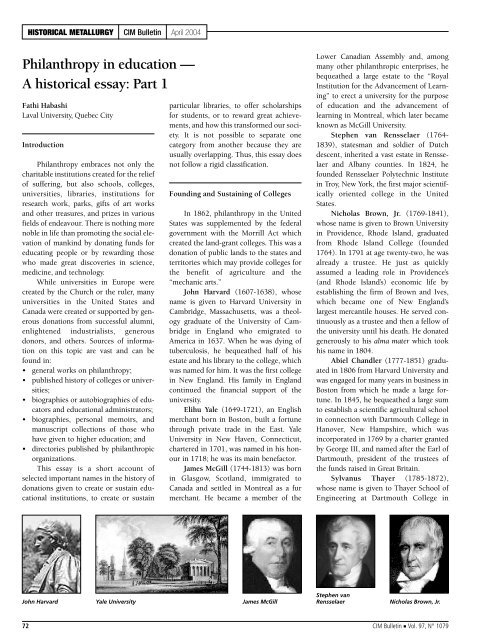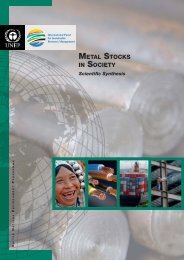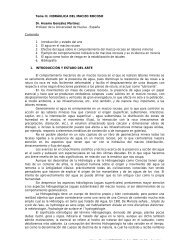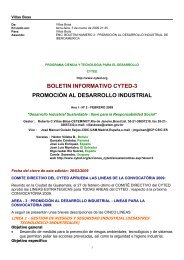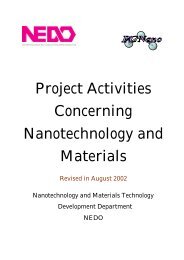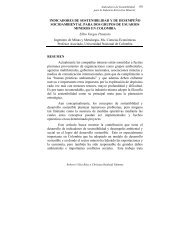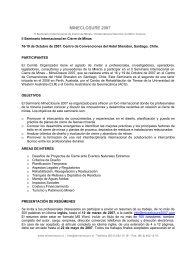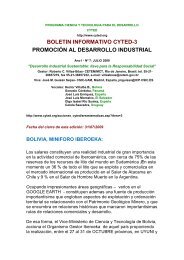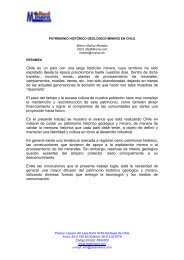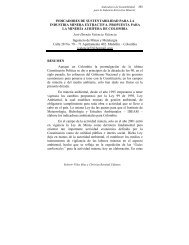Philanthropy in Education - a Historical Essay (Part I)
Philanthropy in Education - a Historical Essay (Part I)
Philanthropy in Education - a Historical Essay (Part I)
You also want an ePaper? Increase the reach of your titles
YUMPU automatically turns print PDFs into web optimized ePapers that Google loves.
HISTORICAL METALLURGY CIM Bullet<strong>in</strong> April 2004<br />
<strong>Philanthropy</strong> <strong>in</strong> education —<br />
A historical essay: <strong>Part</strong> 1<br />
Fathi Habashi<br />
Laval University, Quebec City<br />
Introduction<br />
<strong>Philanthropy</strong> embraces not only the<br />
charitable <strong>in</strong>stitutions created for the relief<br />
of suffer<strong>in</strong>g, but also schools, colleges,<br />
universities, libraries, <strong>in</strong>stitutions for<br />
research work, parks, gifts of art works<br />
and other treasures, and prizes <strong>in</strong> various<br />
fields of endeavour. There is noth<strong>in</strong>g more<br />
noble <strong>in</strong> life than promot<strong>in</strong>g the social elevation<br />
of mank<strong>in</strong>d by donat<strong>in</strong>g funds for<br />
educat<strong>in</strong>g people or by reward<strong>in</strong>g those<br />
who made great discoveries <strong>in</strong> science,<br />
medic<strong>in</strong>e, and technology.<br />
While universities <strong>in</strong> Europe were<br />
created by the Church or the ruler, many<br />
universities <strong>in</strong> the United States and<br />
Canada were created or supported by generous<br />
donations from successful alumni,<br />
enlightened <strong>in</strong>dustrialists, generous<br />
donors, and others. Sources of <strong>in</strong>formation<br />
on this topic are vast and can be<br />
found <strong>in</strong>:<br />
• general works on philanthropy;<br />
• published history of colleges or universities;<br />
• biographies or autobiographies of educators<br />
and educational adm<strong>in</strong>istrators;<br />
• biographies, personal memoirs, and<br />
manuscript collections of those who<br />
have given to higher education; and<br />
• directories published by philanthropic<br />
organizations.<br />
This essay is a short account of<br />
selected important names <strong>in</strong> the history of<br />
donations given to create or susta<strong>in</strong> educational<br />
<strong>in</strong>stitutions, to create or susta<strong>in</strong><br />
particular libraries, to offer scholarships<br />
for students, or to reward great achievements,<br />
and how this transformed our society.<br />
It is not possible to separate one<br />
category from another because they are<br />
usually overlapp<strong>in</strong>g. Thus, this essay does<br />
not follow a rigid classification.<br />
Found<strong>in</strong>g and Susta<strong>in</strong><strong>in</strong>g of Colleges<br />
In 1862, philanthropy <strong>in</strong> the United<br />
States was supplemented by the federal<br />
government with the Morrill Act which<br />
created the land-grant colleges. This was a<br />
donation of public lands to the states and<br />
territories which may provide colleges for<br />
the benefit of agriculture and the<br />
“mechanic arts.”<br />
John Harvard (1607-1638), whose<br />
name is given to Harvard University <strong>in</strong><br />
Cambridge, Massachusetts, was a theology<br />
graduate of the University of Cambridge<br />
<strong>in</strong> England who emigrated to<br />
America <strong>in</strong> 1637. When he was dy<strong>in</strong>g of<br />
tuberculosis, he bequeathed half of his<br />
estate and his library to the college, which<br />
was named for him. It was the first college<br />
<strong>in</strong> New England. His family <strong>in</strong> England<br />
cont<strong>in</strong>ued the f<strong>in</strong>ancial support of the<br />
university.<br />
Elihu Yale (1649-1721), an English<br />
merchant born <strong>in</strong> Boston, built a fortune<br />
through private trade <strong>in</strong> the East. Yale<br />
University <strong>in</strong> New Haven, Connecticut,<br />
chartered <strong>in</strong> 1701, was named <strong>in</strong> his honour<br />
<strong>in</strong> 1718; he was its ma<strong>in</strong> benefactor.<br />
James McGill (1744-1813) was born<br />
<strong>in</strong> Glasgow, Scotland, immigrated to<br />
Canada and settled <strong>in</strong> Montreal as a fur<br />
merchant. He became a member of the<br />
Lower Canadian Assembly and, among<br />
many other philanthropic enterprises, he<br />
bequeathed a large estate to the “Royal<br />
Institution for the Advancement of Learn<strong>in</strong>g”<br />
to erect a university for the purpose<br />
of education and the advancement of<br />
learn<strong>in</strong>g <strong>in</strong> Montreal, which later became<br />
known as McGill University.<br />
Stephen van Rensselaer (1764-<br />
1839), statesman and soldier of Dutch<br />
descent, <strong>in</strong>herited a vast estate <strong>in</strong> Rensselaer<br />
and Albany counties. In 1824, he<br />
founded Rensselaer Polytechnic Institute<br />
<strong>in</strong> Troy, New York, the first major scientifically<br />
oriented college <strong>in</strong> the United<br />
States.<br />
Nicholas Brown, Jr. (1769-1841),<br />
whose name is given to Brown University<br />
<strong>in</strong> Providence, Rhode Island, graduated<br />
from Rhode Island College (founded<br />
1764). In 1791 at age twenty-two, he was<br />
already a trustee. He just as quickly<br />
assumed a lead<strong>in</strong>g role <strong>in</strong> Providence’s<br />
(and Rhode Island’s) economic life by<br />
establish<strong>in</strong>g the firm of Brown and Ives,<br />
which became one of New England’s<br />
largest mercantile houses. He served cont<strong>in</strong>uously<br />
as a trustee and then a fellow of<br />
the university until his death. He donated<br />
generously to his alma mater which took<br />
his name <strong>in</strong> 1804.<br />
Abiel Chandler (1777-1851) graduated<br />
<strong>in</strong> 1806 from Harvard University and<br />
was engaged for many years <strong>in</strong> bus<strong>in</strong>ess <strong>in</strong><br />
Boston from which he made a large fortune.<br />
In 1845, he bequeathed a large sum<br />
to establish a scientific agricultural school<br />
<strong>in</strong> connection with Dartmouth College <strong>in</strong><br />
Hanover, New Hampshire, which was<br />
<strong>in</strong>corporated <strong>in</strong> 1769 by a charter granted<br />
by George III, and named after the Earl of<br />
Dartmouth, president of the trustees of<br />
the funds raised <strong>in</strong> Great Brita<strong>in</strong>.<br />
Sylvanus Thayer (1785-1872),<br />
whose name is given to Thayer School of<br />
Eng<strong>in</strong>eer<strong>in</strong>g at Dartmouth College <strong>in</strong><br />
John Harvard<br />
Yale University<br />
James McGill<br />
Stephen van<br />
Rensselaer<br />
Nicholas Brown, Jr.<br />
72 CIM Bullet<strong>in</strong> ■ Vol. 97, N° 1079
April 2004 CIM Bullet<strong>in</strong> HISTORICAL METALLURGY<br />
Sylvanus Thayer<br />
Peter Cooper<br />
Chauncey Rose<br />
Cornelius Vanderbilt<br />
Edw<strong>in</strong> A. Stevens<br />
James Lick<br />
Hanover, New Hampshire (now University<br />
of New Hampshire), was born <strong>in</strong><br />
Bra<strong>in</strong>tree, Massachusetts. He graduated<br />
from Dartmouth <strong>in</strong> 1807, then attended<br />
the United States Military Academy at<br />
West Po<strong>in</strong>t <strong>in</strong> New York. In 1815, he was<br />
sent to Europe to exam<strong>in</strong>e military works<br />
and schools. On his return <strong>in</strong> 1817, he<br />
was appo<strong>in</strong>ted super<strong>in</strong>tendent of the Military<br />
Academy where he stayed sixteen<br />
years. On leav<strong>in</strong>g West Po<strong>in</strong>t, he was<br />
made president of the Board of Eng<strong>in</strong>eers.<br />
He received honorary degrees from Dartmouth,<br />
Harvard, and others. He donated<br />
generously to the School of Eng<strong>in</strong>eer<strong>in</strong>g at<br />
Dartmouth College and other establishments.<br />
Peter Cooper (1791-1883) was a<br />
work<strong>in</strong>gman’s son who had less than a<br />
year of formal school<strong>in</strong>g, yet he went on<br />
to become an <strong>in</strong>dustrialist and an <strong>in</strong>ventor.<br />
He made his fortune with a glue factory<br />
and an iron foundry. Later, he turned<br />
his entrepreneurial skills to successful<br />
ventures <strong>in</strong> real estate, <strong>in</strong>surance, railroads,<br />
and telegraphy. Cooper never forgot<br />
his humble orig<strong>in</strong>. He thought children of<br />
immigrants and the work<strong>in</strong>g class<br />
deserved access to education. Believ<strong>in</strong>g<br />
that education should be “as free as water<br />
and air,” and <strong>in</strong>spired by a polytechnic<br />
school <strong>in</strong> Paris, he spent the last 30 years<br />
of his life creat<strong>in</strong>g and nurtur<strong>in</strong>g a school<br />
for the “boys and girls of this city, who had<br />
no better opportunity than I.” As one of<br />
the first colleges to offer a free education<br />
to work<strong>in</strong>g-class children and to women,<br />
Cooper Union, <strong>in</strong> New York City, was a<br />
pioneer school long before access to education<br />
became public policy.<br />
Cooper Union also provided a public<br />
library and a meet<strong>in</strong>g place for artists and<br />
<strong>in</strong>ventors. In the Great Hall, the public<br />
heard social and political reformers as well<br />
as free lectures on science and government.<br />
Before they were elected, Presidents<br />
L<strong>in</strong>coln, Grant, Cleveland, Taft, and<br />
Theodore Roosevelt spoke <strong>in</strong> the celebrated<br />
auditorium. As presidents,<br />
Woodrow Wilson and Bill Cl<strong>in</strong>ton also<br />
gave speeches there. Today, the Great Hall<br />
cont<strong>in</strong>ues as a home for public forums,<br />
cultural events, and community activities.<br />
Cooper Union is also the place where<br />
<strong>in</strong>ventor Thomas Edison and Supreme<br />
Court Judge Felix Frankfurter were students,<br />
and where the Red Cross and the<br />
National Association for the Advancement<br />
of Colored People were organized.<br />
Chauncey Rose (1794-1877) was<br />
born <strong>in</strong> Connecticut. At the age of 23, he<br />
moved westward f<strong>in</strong>ally settl<strong>in</strong>g <strong>in</strong> Terre<br />
Haute, Indiana, which had been laid out<br />
only a year earlier. He engaged <strong>in</strong> trade<br />
and became a successful merchant. He<br />
arranged for the construction of the Terre<br />
Haute and Indianapolis Railroad, and was<br />
a major contributor to Wabash College<br />
and State Normal School, now Indiana<br />
State University.<br />
Cornelius Vanderbilt (1794-1877)<br />
founded Vanderbilt University <strong>in</strong><br />
Nashville, Tennessee, <strong>in</strong> 1875. Dur<strong>in</strong>g the<br />
Civil War, he became <strong>in</strong>terested <strong>in</strong> the railroads,<br />
and by 1867 controlled New York<br />
Central Railroad. He expanded his railroad<br />
empire and amassed a large fortune.<br />
His son, William H. Vanderbilt (1821-<br />
1885), succeeded his father as president of<br />
New York Central Railroad. One of his<br />
sons, Cornelius Vanderbilt (1843-1899),<br />
helped found the Cathedral of Sa<strong>in</strong>t John<br />
the Div<strong>in</strong>e <strong>in</strong> New York City. The other<br />
son, Georges Wash<strong>in</strong>gton Vanderbilt<br />
(1862-1914), donated land for the Teachers<br />
College of Columbia University.<br />
Edw<strong>in</strong> A. Stevens (1795-1868) was a<br />
pioneer builder of iron-clad warships. In<br />
1870, his widow founded the Stevens<br />
Institute of Technology <strong>in</strong> Hoboken, New<br />
Jersey, <strong>in</strong> his memory.<br />
James Lick (1796-1876), a Dutchman,<br />
was born <strong>in</strong> Fredericksburg, Pennsylvania.<br />
A piano and organ maker by<br />
trade, at age twenty-five he sailed for<br />
South America, where his bus<strong>in</strong>ess flourished.<br />
Early <strong>in</strong> 1848, he came to San Francisco<br />
dur<strong>in</strong>g the gold rush and made a<br />
fortune through real estate <strong>in</strong>vestments.<br />
He owned valuable property <strong>in</strong> the heart<br />
of San Francisco, and built the most elegant<br />
hotel of its day. In 1873, he contacted<br />
the president of the California Academy of<br />
Sciences and bequeathed his entire fortune<br />
for the construction, <strong>in</strong> California, of<br />
the largest astronomical observatory at<br />
that time, which became known as the<br />
Lick Astronomical Department of the<br />
Johns Hopk<strong>in</strong>s<br />
John Purdue Ezra Cornell William McMaster Amos G. Throop<br />
William M. Rice<br />
April 2004 73
HISTORICAL METALLURGY CIM Bullet<strong>in</strong> April 2004<br />
Lydia Moss Bradley<br />
Philip D. Armour Leonard Case, Jr.<br />
George Hearst<br />
Leland Stanford A.J. Drexel<br />
newly founded University of California.<br />
The observatory was opened <strong>in</strong> 1888,<br />
twelve years after Lick’s death.<br />
Johns Hopk<strong>in</strong>s (1795-1873), founder<br />
of the university and hospital known by<br />
his name <strong>in</strong> Baltimore, Maryland, was born<br />
at Whitehall, his family’s tobacco plantation<br />
<strong>in</strong> Maryland. Hav<strong>in</strong>g amassed a great<br />
fortune after a long and highly successful<br />
career <strong>in</strong> trade and bank<strong>in</strong>g, Johns Hopk<strong>in</strong>s<br />
felt an obligation to share his wealth.<br />
Guided by the strong social consciousness<br />
of his Quaker faith, he chose to use his fortune<br />
to create a university which opened<br />
<strong>in</strong> 1876, three years after his death. In<br />
1889, the Hospital and Tra<strong>in</strong><strong>in</strong>g School of<br />
Medic<strong>in</strong>e was launched. Later additions to<br />
the health divisions of the university<br />
<strong>in</strong>clude the School of Hygiene and Public<br />
Health <strong>in</strong> 1918.<br />
John Purdue (1802-1876), a wealthy<br />
bachelor from Lafayette, Indiana, made a<br />
fortune dur<strong>in</strong>g the Civil War <strong>in</strong> cattle<br />
farm<strong>in</strong>g, silver and gold m<strong>in</strong><strong>in</strong>g, and other<br />
bus<strong>in</strong>esses. In 1869, he donated a large<br />
sum of money for the f<strong>in</strong>anc<strong>in</strong>g of a landgrant<br />
university <strong>in</strong> his hometown that was<br />
named after him.<br />
Asa Packer (1805-1879) was born <strong>in</strong><br />
Connecticut, but settled <strong>in</strong> the Lehigh Valley,<br />
where he became the owner of a canalboat<br />
that carried coal to Philadelphia. He<br />
built railways and established a large fortune.<br />
He donated generously for a technical<br />
college, which later became Lehigh<br />
University, chartered <strong>in</strong> 1866.<br />
Ezra Cornell (1807-1874), founder<br />
of Cornell University <strong>in</strong> Ithaca, New York,<br />
<strong>in</strong> 1865 (opened <strong>in</strong> 1868), was an American<br />
capitalist who was founder and director<br />
of the Western Union Telegraph<br />
Company <strong>in</strong> 1855. His son, Alonzo B.<br />
Cornell (1832-1904), was governor of<br />
New York from 1880 to 1883.<br />
William McMaster (1811-1887),<br />
whose name is given to McMaster University<br />
<strong>in</strong> Hamilton, Ontario, immigrated to<br />
Canada from Ireland <strong>in</strong> 1833 and became<br />
a successful merchant. He was one of the<br />
founders of the Canadian Bank of Commerce<br />
<strong>in</strong> 1867. Funds from his estate were<br />
used to establish McMaster University <strong>in</strong><br />
1890.<br />
Amos G. Throop (1811-1894), a<br />
bus<strong>in</strong>essman and philanthropist, was<br />
mayor of Pasadena, California. In 1891, he<br />
founded a School of Arts and Crafts, <strong>in</strong>itially<br />
named Throop University. In 1907,<br />
the school became the College of Science<br />
and Technology that conferred Bachelor of<br />
Science degrees <strong>in</strong> electrical, mechanical,<br />
and civil eng<strong>in</strong>eer<strong>in</strong>g. It was renamed<br />
Throop Polytechnic Institute, and s<strong>in</strong>ce<br />
1920, the California Institute of Technology.<br />
The physicist and later Nobel Prize<br />
w<strong>in</strong>ner, Robert A. Millikan, was head of<br />
the school from 1921 until his retirement.<br />
William M. Rice (1816-1900), whose<br />
name is given to Rice University <strong>in</strong> Houston,<br />
Texas, was born <strong>in</strong> Spr<strong>in</strong>gfield, Massachusetts.<br />
His father was <strong>in</strong>strumental <strong>in</strong><br />
the construction of the first high school <strong>in</strong><br />
town. The young boy dropped out of<br />
school at the age of 15 to work <strong>in</strong> a grocery<br />
store. After a few years, he opened his<br />
own bus<strong>in</strong>ess, then left <strong>in</strong> 1837 to the<br />
newly annexed state of Texas, shipp<strong>in</strong>g his<br />
merchandise by sea. Unfortunately, his<br />
merchandise was lost and he became penniless.<br />
He was given a land grant and, <strong>in</strong><br />
1844, he entered <strong>in</strong>to the cotton bus<strong>in</strong>ess,<br />
which was very successful. In 1852, he<br />
<strong>in</strong>vested <strong>in</strong> the first railroad <strong>in</strong> Texas and<br />
then started buy<strong>in</strong>g forest land. His accumulated<br />
fortune was doubled when he<br />
married the widow of a wealthy<br />
landowner. At the age of 60, childless, he<br />
decided to fund an <strong>in</strong>stitute of higher<br />
learn<strong>in</strong>g <strong>in</strong> Houston. The charter of the<br />
William M. Rice Institute for the Advancement<br />
of Literature, Science, and Art was<br />
signed <strong>in</strong> 1891. After the death of his wife,<br />
he left the bulk of his estate to the Institute.<br />
“Texas received me when I was penniless,<br />
without friends or even<br />
acqua<strong>in</strong>tances,” he wrote. “And now <strong>in</strong><br />
the even<strong>in</strong>g of my life, I recognize my<br />
obligation to her and her children. I wish<br />
now to leave to the boys and girls struggl<strong>in</strong>g<br />
for a place <strong>in</strong> the sun the fortune I<br />
have been able to accumulate.”<br />
Lydia Moss Bradley (1816-1907),<br />
founder of the Bradley Polytechnic Institute<br />
(now called Bradley University) <strong>in</strong><br />
Peoria, Ill<strong>in</strong>ois, was the first female member<br />
of an American national bank board <strong>in</strong><br />
the United States when she jo<strong>in</strong>ed the<br />
Board of Directors of Peoria’s First National<br />
Charles Pratt<br />
John Williams Mackay<br />
Andrew Carnegie<br />
James Douglas<br />
John D. Rockefeller<br />
Georges West<strong>in</strong>ghouse<br />
74 CIM Bullet<strong>in</strong> ■ Vol. 97, N° 1079
April 2004 CIM Bullet<strong>in</strong> HISTORICAL METALLURGY<br />
Julius Wernher<br />
Andrew Mellon James B. Duke William Volker Henry Ford<br />
Charles Mart<strong>in</strong> Hall<br />
Bank <strong>in</strong> 1875. She gave land to the Society<br />
of St. Francis to build a hospital, now<br />
known as the St. Francis Medical Center. In<br />
1884, she built the Bradley Home for Aged<br />
Women to care for widowed and childless<br />
women and helped to establish the first<br />
park system <strong>in</strong> Ill<strong>in</strong>ois. But the project<br />
dearest to her was the school, which she<br />
established to honour her husband, Tobias,<br />
and her six children, all of whom died at an<br />
early age. Tobias Bradley was a successful<br />
merchant and bus<strong>in</strong>essman <strong>in</strong> bank<strong>in</strong>g,<br />
railroads, steamboats, distilleries, and real<br />
estate. Bradley University became a fouryear<br />
college <strong>in</strong> 1920 and has cont<strong>in</strong>ued to<br />
grow ever s<strong>in</strong>ce.<br />
Philip D. Armour (1832-1901) was<br />
born <strong>in</strong> Stockbridge, New York, worked as<br />
a m<strong>in</strong>er <strong>in</strong> California from 1852 to 1856,<br />
and later became a pioneer <strong>in</strong> the meat<br />
pack<strong>in</strong>g <strong>in</strong>dustry <strong>in</strong> Chicago which was<br />
very successful. He became <strong>in</strong>terested <strong>in</strong> a<br />
mission Sunday school to which he contributed<br />
liberally for its support. This mission,<br />
started <strong>in</strong> 1874, three years after the<br />
Chicago Fire, was called Plymouth Mission<br />
because it was an extension of the<br />
activities of Plymouth Church, of which<br />
he was a member. The “Armour Mission”<br />
was to be broad and wholly non-sectarian,<br />
free and open to all without restrictions as<br />
to race, creed, or class. In 1887, the mission<br />
librarian started a class <strong>in</strong> clay modell<strong>in</strong>g,<br />
woodcarv<strong>in</strong>g, and other hobbies<br />
which were very popular. This was the<br />
beg<strong>in</strong>n<strong>in</strong>g of the Armour Institute of Technology<br />
<strong>in</strong> 1892, a technical college with<br />
departments of m<strong>in</strong><strong>in</strong>g, mechanical and<br />
electrical eng<strong>in</strong>eer<strong>in</strong>g, architecture, library<br />
science, domestic arts, commerce, music,<br />
and others. The World Exposition held <strong>in</strong><br />
Chicago <strong>in</strong> the same year had been one of<br />
the pr<strong>in</strong>cipal sources for supply<strong>in</strong>g equipment<br />
to the college. M<strong>in</strong><strong>in</strong>g eng<strong>in</strong>eer<strong>in</strong>g<br />
was discont<strong>in</strong>ued and replaced by civil<br />
eng<strong>in</strong>eer<strong>in</strong>g <strong>in</strong> 1899, chemical eng<strong>in</strong>eer<strong>in</strong>g<br />
<strong>in</strong> 1901, and fire protection eng<strong>in</strong>eer<strong>in</strong>g,<br />
the only course of its k<strong>in</strong>d <strong>in</strong> the<br />
country, <strong>in</strong> 1903. In 1940, it consolidated<br />
with the Lewis Institute to form the Ill<strong>in</strong>ois<br />
Institute of Technology <strong>in</strong> Chicago.<br />
Leonard Case, Jr. (1820-1880), a<br />
Yale College law graduate, <strong>in</strong>herited a<br />
large estate <strong>in</strong> Cleveland, Ohio, from his<br />
father <strong>in</strong> 1842. Rather than practic<strong>in</strong>g law,<br />
he spent his time work<strong>in</strong>g out mathematical<br />
problems, collect<strong>in</strong>g stuffed birds,<br />
rock specimens and other items considered<br />
to be a forebear of the Cleveland<br />
Museum of Natural History. In 1870, he<br />
gave the Cleveland Library Association an<br />
endowment and, <strong>in</strong> 1877, he began lay<strong>in</strong>g<br />
the groundwork for the Case School of<br />
Applied Science by donat<strong>in</strong>g real estate to<br />
a trust that would provide an endowment<br />
for a new eng<strong>in</strong>eer<strong>in</strong>g school. The School<br />
was opened <strong>in</strong> downtown Cleveland four<br />
months after his death. The school moved<br />
to its current site, adjacent to Western<br />
Reserve, <strong>in</strong> 1883. The name Case Institute<br />
of Technology was adopted <strong>in</strong> 1947 to<br />
reflect the <strong>in</strong>stitution’s grow<strong>in</strong>g stature.<br />
In 1967, Case Institute of Technology<br />
jo<strong>in</strong>ed Western Reserve University to<br />
become Case Western. The two <strong>in</strong>stitutions<br />
had shared adjacent campuses s<strong>in</strong>ce<br />
the late n<strong>in</strong>eteenth century, and were<br />
<strong>in</strong>volved <strong>in</strong> cooperative efforts for many<br />
years. Western Reserve College was<br />
founded <strong>in</strong> 1826 <strong>in</strong> Hudson, Ohio, a town<br />
about 40 km southeast of Cleveland. The<br />
college took its name from that of the<br />
region, which at the time of the American<br />
Revolution was known as the Western<br />
Reserve of Connecticut. In 1882, renamed<br />
Western Reserve University, the <strong>in</strong>stitution<br />
moved to the Cleveland site that later<br />
became known as University Circle.<br />
The tradition of contribut<strong>in</strong>g to education<br />
and culture <strong>in</strong> Cleveland can be<br />
traced back to Leonard’s father, who had<br />
begun life as a farmer, but turned to the<br />
study of mathematics, survey<strong>in</strong>g, and law.<br />
He became a banker and railroad promoter,<br />
and over time, amassed the largest<br />
fortune <strong>in</strong> Cleveland. He was also devoted<br />
to the city and served as President of<br />
Cleveland Village, as it was known at the<br />
time.<br />
George Hearst (1820-1891) was an<br />
American m<strong>in</strong><strong>in</strong>g magnate and senator<br />
from California. His widow donated freely<br />
to the University of California. His son,<br />
William Randolph Hearst (1863-1951),<br />
journalist and publisher, who founded a<br />
news empire, also donated to the same<br />
university.<br />
Leland Stanford (1824-1893), an<br />
American railroad builder, senator from<br />
California, and philanthropist, founded<br />
Leland Stanford, Jr. University, later<br />
renamed Stanford University, <strong>in</strong> Palo Alto,<br />
California, <strong>in</strong> 1885 after the death of his<br />
only son. His widow cont<strong>in</strong>ued to aid the<br />
university.<br />
Joseph Wharton (1826-1908) was<br />
born <strong>in</strong> Philadelphia. He was among the<br />
first to establish the manufacture of spelter,<br />
nickel, and cobalt <strong>in</strong> this country, and<br />
was the first to make magnetic needles. He<br />
owned the deposits of nickel ore <strong>in</strong> Lancaster<br />
County, Pennsylvania, and established<br />
his works <strong>in</strong> Camden, New Jersey.<br />
Between 1853 and 1863, he was the manager<br />
and pr<strong>in</strong>cipal stockholder of the<br />
Pennsylvania and Lehigh Z<strong>in</strong>c Company,<br />
with m<strong>in</strong>es and smelters <strong>in</strong> Friedensville,<br />
Pennsylvania. Under his guidance, this<br />
company became the first successful producer<br />
of z<strong>in</strong>c <strong>in</strong> the United States. Wharton<br />
also <strong>in</strong>vested <strong>in</strong> the Bethlehem Iron<br />
Works, which became Bethlehem Steel<br />
Co. The Wharton School of F<strong>in</strong>ance and<br />
Economics was founded by him.<br />
A.J. Drexel (1826-1893), whose<br />
name is given to the Drexel Institute of<br />
Technology which opened <strong>in</strong> 1892 <strong>in</strong><br />
Philadelphia, Pennsylvania, was a native<br />
April 2004 75
HISTORICAL METALLURGY CIM Bullet<strong>in</strong> April 2004<br />
of Philadelphia who<br />
developed the family’s<br />
bank<strong>in</strong>g <strong>in</strong>terest<br />
<strong>in</strong>to one of the premier<br />
<strong>in</strong>vestment<br />
bank<strong>in</strong>g firms <strong>in</strong> the<br />
country. The company<br />
was <strong>in</strong>volved<br />
<strong>in</strong> f<strong>in</strong>anc<strong>in</strong>g railroads,<br />
m<strong>in</strong><strong>in</strong>g enter-<br />
Henry Krumb<br />
prises, and real estate ventures. Drexel was<br />
co-owner of the Public Ledger, Philadelphia’s<br />
major daily, <strong>in</strong> the n<strong>in</strong>eteenth century.<br />
He left a large fortune for the<br />
Institute.<br />
Charles Pratt (1830-1891) was born<br />
<strong>in</strong> Watertown, Massachusetts but moved<br />
to New York <strong>in</strong> 1851 where he worked<br />
with a pa<strong>in</strong>t and oil firm. In 1867, he<br />
formed his own company and made a fortune<br />
<strong>in</strong> the oil bus<strong>in</strong>ess. In 1874, his company<br />
merged with Standard Oil Company.<br />
He contributed generously to education,<br />
found<strong>in</strong>g the Pratt Institute <strong>in</strong> 1886,<br />
which opened <strong>in</strong> 1887 <strong>in</strong> Brooklyn, New<br />
York.<br />
John Williams Mackay (1831-1902),<br />
an Irish immigrant who came to the<br />
United States <strong>in</strong> 1840, became the most<br />
powerful figure on Nevada’s Comstock<br />
Lode and <strong>in</strong> other ventures that made him<br />
very wealthy. His widow donated his<br />
estate to build Mackay School of M<strong>in</strong>es <strong>in</strong><br />
Reno, Nevada.<br />
Andrew Carnegie (1835-1919) was<br />
born <strong>in</strong> Scotland, immigrated to the<br />
United States, where he concentrated on<br />
steel production. In 1900, he produced<br />
one quarter of all U.S. steel. He accumulated<br />
enormous wealth, which he donated<br />
for the establishment of libraries, the<br />
Carnegie Institute of Technology <strong>in</strong> Pittsburgh,<br />
Pennsylvania, and many other<br />
establishments. Carnegie supported the<br />
Food Research Institute at Stanford University<br />
and Robert A. Millikan’s atomic<br />
research at the California Institute of<br />
Technology among others.<br />
James Douglas (1837-1918), a Canadian<br />
graduate of Queen’s University <strong>in</strong><br />
K<strong>in</strong>gston, Ontario, made a fortune from<br />
m<strong>in</strong><strong>in</strong>g <strong>in</strong> Arizona, and donated generously<br />
to the Arizona School of M<strong>in</strong>es as<br />
well as to his alma mater.<br />
John D. Rockefeller (1839-1937)<br />
dom<strong>in</strong>ated the U.S. oil ref<strong>in</strong><strong>in</strong>g <strong>in</strong>dustry<br />
George E. Merrick<br />
Harvey Seeley Mudd<br />
through his Standard Oil Company by<br />
strict economy, mergers with competitors,<br />
and ruthless crush<strong>in</strong>g of opponents. He<br />
founded the University of Chicago <strong>in</strong><br />
1892, and established the Rockefeller<br />
Institute for Medical Research <strong>in</strong> 1901 <strong>in</strong><br />
New York City. In 1913, he created the<br />
Rockefeller Foundation to promote public<br />
health and to further science. His only<br />
son, John D. Rockefeller, Jr. (1874-1960)<br />
graduated from Brown University <strong>in</strong> Providence,<br />
Rhode Island, <strong>in</strong> 1897, donated<br />
funds for massive public health campaigns<br />
to eradicate disease, to the restoration of<br />
Colonial Williamsburg, the dedication of<br />
new national parks, to provid<strong>in</strong>g a home<br />
site for the United Nations, and funnelled<br />
millions of dollars <strong>in</strong>to colleges and universities.<br />
The Rockefeller Center <strong>in</strong> Central<br />
Manhattan, New York City was built<br />
from 1931-1939, and comprises 14 build<strong>in</strong>gs<br />
<strong>in</strong>clud<strong>in</strong>g a 70-story skyscraper and a<br />
radio and enterta<strong>in</strong>ment section (Radio<br />
City). Rockefeller supported the cyclotron<br />
at the University of California, and Mount<br />
Wilson Observatory at the California<br />
Institute of Technology, the Russian Institute<br />
at Columbia University, work by<br />
chemist L<strong>in</strong>us Paul<strong>in</strong>g and zoologist<br />
Thomas Hunt Morgan, the science of<br />
enzymology, and James Breasted’s Oriental<br />
Institute at the University Chicago, among<br />
others.<br />
Georges West<strong>in</strong>ghouse (1846-1914),<br />
an American <strong>in</strong>ventor and manufacturer,<br />
was <strong>in</strong>fluential <strong>in</strong> <strong>in</strong>troduc<strong>in</strong>g alternat<strong>in</strong>g<br />
current <strong>in</strong> the United States. He created<br />
the West<strong>in</strong>ghouse <strong>Education</strong>al Foundation.<br />
Julius Wernher (1850-1912) was<br />
born <strong>in</strong> Darmstadt, Germany, but went to<br />
London <strong>in</strong> 1871 shortly after the Franco-<br />
Prussian war. He was offered a job by a<br />
diamond dealer <strong>in</strong> London to go to South<br />
Africa and act as his agent <strong>in</strong> the m<strong>in</strong><strong>in</strong>g<br />
town of Kimberley. Wernher soon formed<br />
his own company<br />
and amassed a large<br />
fortune <strong>in</strong> the diamond<br />
bus<strong>in</strong>ess. He<br />
was <strong>in</strong>strumental <strong>in</strong><br />
the found<strong>in</strong>g of the<br />
Imperial College <strong>in</strong><br />
London, and the<br />
Wilhelm Kroll build<strong>in</strong>g of the<br />
Royal School of<br />
M<strong>in</strong>es <strong>in</strong> South Kens<strong>in</strong>gton. He was an<br />
avid art collector and philanthropist. He<br />
donated his art collection to the City of<br />
London.<br />
Andrew Mellon (1855-1937) was a<br />
f<strong>in</strong>ancier, <strong>in</strong>dustrialist, and public official<br />
who made a fortune <strong>in</strong> the alum<strong>in</strong>um<br />
<strong>in</strong>dustry. He created the Mellon <strong>Education</strong>al<br />
and Charitable Trust. The Mellon<br />
Institute of Science was named <strong>in</strong> his honour,<br />
and later merged with the Carnegie<br />
Institute of Technology <strong>in</strong> 1967 to become<br />
Carnegie-Mellon University <strong>in</strong> Pittsburgh,<br />
Pennsylvania. The National Gallery of<br />
Arts also resulted from his benefactions.<br />
He was U.S. Secretary of Treasury <strong>in</strong> 1921-<br />
1931.<br />
James B. Duke (1856-1925), whose<br />
name was given to Duke University <strong>in</strong><br />
Durham, North Carol<strong>in</strong>a (formerly<br />
known as Tr<strong>in</strong>ity College), founded <strong>in</strong><br />
1838, was born near Durham. He organized<br />
the American Tobacco Company of<br />
which he was president until 1912. Thereafter,<br />
he largely devoted his time to the<br />
British American Tobacco Company and<br />
to vast water-power developments. In<br />
1924, he created a large trust to aid charities<br />
and to support the university, which<br />
consisted of more than 50 build<strong>in</strong>gs<br />
located on two campuses, constructed<br />
from 1925-1930.<br />
William Volker (1859-1947) was<br />
born <strong>in</strong>to a prosperous household <strong>in</strong><br />
Hanover, Germany. At age 12, the family<br />
immigrated to the United States. After a<br />
few years <strong>in</strong> Chicago, the young boy<br />
established commerce <strong>in</strong> Kansas City <strong>in</strong><br />
1882, and by 1902, was a millionaire.<br />
Besides his numerous anonymous gifts to<br />
charitable organizations, he donated generously<br />
to the newly founded University<br />
of Kansas City.<br />
Henry Ford (1863-1947), pioneer<br />
automobile manufacturer, and his son<br />
Edsel (1893-1943) founded the Ford<br />
76 CIM Bullet<strong>in</strong> ■ Vol. 97, N° 1079
April 2004 CIM Bullet<strong>in</strong> HISTORICAL METALLURGY<br />
Foundation <strong>in</strong> 1936. After the death of the<br />
benefactors, the foundation acquired 90%<br />
of the Ford Motor Company stock. In<br />
1951, it created the Fund for the Advancement<br />
of <strong>Education</strong>.<br />
Charles Mart<strong>in</strong> Hall (1863-1914)<br />
was educated at Oberl<strong>in</strong> College <strong>in</strong> Ohio.<br />
While there, he discovered, <strong>in</strong> 1886, the<br />
modern method of extract<strong>in</strong>g alum<strong>in</strong>um<br />
by the electrolysis of Al 2 O 3 <strong>in</strong> fused cryolite.<br />
He became vice-president of the Alum<strong>in</strong>um<br />
Company of America, and later<br />
donated his fortune to his alma mater.<br />
Henry Krumb (1875-1958), a successful<br />
m<strong>in</strong><strong>in</strong>g eng<strong>in</strong>eer, graduated from<br />
the Columbia School of M<strong>in</strong>es and<br />
donated generously to his alma mater. In<br />
1958, the school was named after him.<br />
George E. Merrick (1886-1942) was<br />
born <strong>in</strong> Spr<strong>in</strong>gdale, Pennsylvania. In<br />
1898, he moved with his family to Miami,<br />
Florida, and later <strong>in</strong>herited large citrus<br />
groves from his father. Beg<strong>in</strong>n<strong>in</strong>g <strong>in</strong> 1912,<br />
he developed Coral Gables, near Miami,<br />
<strong>in</strong>to a famous resort. From the fortune he<br />
accumulated, he established the University<br />
of Miami <strong>in</strong> 1925.<br />
Harvey Seeley Mudd (1888-1955)<br />
was born <strong>in</strong> Leadville, Colorado, and<br />
studied at Stanford and Columbia universities.<br />
With his father, Seeley W. Mudd, he<br />
founded and later became president of<br />
Cyprus M<strong>in</strong>es Corporation, whose Los<br />
Angeles-based headquarters started with<br />
the development of the copper m<strong>in</strong>es on<br />
the island of Cyprus. He served as president<br />
of the American Institute of M<strong>in</strong><strong>in</strong>g<br />
and Metallurgical Eng<strong>in</strong>eers <strong>in</strong> New York,<br />
and founded a college <strong>in</strong> Claremont, California,<br />
which was named after him and<br />
opened shortly after his death.<br />
Wilhelm Kroll (1889-1973) was born<br />
<strong>in</strong> Luxembourg, the son of a metallurgist.<br />
He had his private research laboratory but<br />
had to flee to the United States <strong>in</strong> 1940<br />
when Nazi troops were advanc<strong>in</strong>g <strong>in</strong><br />
Europe. He jo<strong>in</strong>ed the US Bureau of M<strong>in</strong>es<br />
<strong>in</strong> Albany, Oregon, where he further<br />
developed his research on the production<br />
of zirconium and titanium. In the 1950s,<br />
he produced titanium on a commercial<br />
scale. On his retirement <strong>in</strong> 1960 to his<br />
hometown <strong>in</strong> Europe, he donated generously<br />
to the Colorado School of M<strong>in</strong>es,<br />
where the Kroll Institute for Extractive<br />
Metallurgy was founded <strong>in</strong> 1973.<br />
Suggested Read<strong>in</strong>gs<br />
ALEXANDER, E.P., 1989. Museums <strong>in</strong><br />
Motion: An Introduction to the History<br />
and Functions of Museums. American<br />
Association for State and Local History,<br />
Nashville, Tennessee. Seventh pr<strong>in</strong>t<strong>in</strong>g<br />
(first published <strong>in</strong> 1907), 308 p.<br />
ANONYMOUS, 1992. Opportunities for a<br />
Career <strong>in</strong> M<strong>in</strong><strong>in</strong>g and Metallurgy. The<br />
M<strong>in</strong><strong>in</strong>g and Metallurgical Institute of<br />
America, Larkspur, California, 309 p.<br />
ANONYMOUS, 2003. Canadian Directory to<br />
Foundations and Grants. Canadian Centre<br />
for <strong>Philanthropy</strong>, Toronto.<br />
BALTON, S.K., 1896. Famous Givers and<br />
their Gifts. New York.<br />
CURTI, M. and NASH, R., 1965. <strong>Philanthropy</strong><br />
<strong>in</strong> the Shap<strong>in</strong>g of American Higher <strong>Education</strong>.<br />
Rutgers University Press, New<br />
Brunswick, New Jersey, 340 p.<br />
MYERS, G., 1907. History of the Great American<br />
Fortunes. The Modern Library, New<br />
York, 732 p.<br />
READ, T.T., 1941. The Development of M<strong>in</strong>eral<br />
Industry <strong>Education</strong> <strong>in</strong> the United<br />
States. American Institute of M<strong>in</strong><strong>in</strong>g and<br />
Metallurgical Eng<strong>in</strong>eers, New York, 298 p.


